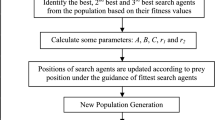Abstract
The gray-level co-occurrence matrix (GLCM) can obtain the pixel matrix of the image, and selecting multiple thresholds for the matrix can obtain better segmentation results. However, as the number of threshold increases, the computational complexity of the algorithm will also increase. In order to solve this problem, this paper proposes a multi-threshold image segmentation method based on thermal exchange optimization (TEO) algorithm, and take a novel diagonal class entropy (DCE) as the fitness function. We improve TEO algorithm by using two strategic methods of Levy flight (LF) and opposition-based learning (OBL). In order to verify the segmentation ability of the proposed algorithm, color natural images, satellite images and Berkeley images are taken as experimental objects to analyze the segmentation result graph and image segmentation quality evaluation indexes. Experimental results show that the GLCM-ITEO algorithm has good segmentation capability, less CPU time.















Similar content being viewed by others
References
Ahmed AE, Mohamed AE, Essam HH (2018) Improved grasshopper optimization algorithm using opposition-based learning. Expert Syst Appl 112:156–172
Akram F, Garcia MA, Puig D (2017) Active contours driven by local and global fitted image models for image segmentation robust to intensity inhomogeneity. PLoS One 12(4):e0174813
Askarzadeh, Alireza (2016) A novel metaheuristic method for solving constrained engineering optimization problems: crow search algorithm. Comput Struct 169:1–12
Becker AS, Wagner MW, Wurnig MC et al (2017) Diffusion-weighted imaging of the abdomen: impact of b-values on texture analysis features. NMR Biomed 30(1):e3669
Biyanto TR et al (2017) Killer whale algorithm: an algorithm inspired by the life of killer whale. Proc Comput Sci 124:151–157
Bouchekara HREH, Chaib AE, Abido MA et al (2016) Optimal power flow using an improved colliding bodies optimization algorithm. Appl Soft Comput 42(C):119–131
Chen Y, Zhang Y, Yang J (2016) Curve-like structure extraction using minimal path propagation with backtracing. IEEE Trans Image Process 25(2):988–1003
Cheng X, Shuai CM, Wang J et al (2018) Building a sustainable development model for China’s poverty-stricken reservoir regions based on system dynamics. J Clean Prod 176:535–554
Dong S, Li H, Wang J et al (2017) Improved flexible Li-ion hybrid capacitors: techniques for superior stability. Nano Res 10(12):4448–4456
Dong W, Kang L, Zhang W (2017) Opposition-based particle swarm optimization with adaptive mutation strategy. Soft Comput 21(17):5081–5090
Fadaei S, Amirfattahi R, Ahmadzadeh MR (2017) New content-based image retrieval system based on optimised integration of DCD, wavelet and curvelet features. IET Image Process 11(2):89–98
Fan L, Clausi DA, Xu L et al (2018) ST-IRGS: a region-based self-training algorithm applied to hyperspectral image classification and segmentation. IEEE Trans Geosci Remote Sens 56(1):3–16
Farag TH, Hassan WA, Ayad HA et al (2017) Extended absolute fuzzy connectedness segmentation algorithm utilizing region and boundary-based information. Arab J Sci Eng 42(8):3573–3583
Fister I Jr et al (2014) A novel hybrid self-adaptive bat algorithm. TheScientificWorldJournal 1–2:709738
Geem ZW, Kim JH, Loganathan GV (2001) A new heuristic optimization algorithm: harmony search. Simulation 76(2):60–68
Goldberg DE, Holland JH (1988) Genetic algorithms and machine learning. Mach Learn 3(2):95–99
Hazirbas C et al (2016) FuseNet: incorporating depth into semantic segmentation via fusion-based CNN architecture. In: Asian conference on computer vision (ACCV). Springer, Cham
He Y, Chiu WC, Keuper M et al (2017) STD2P: RGBD semantic segmentation using spatio-temporal data-driven pooling// Computer Vision & Pattern Recognition
Heidari AA, Pahlavani P (2017) An efficient modified grey wolf optimizer with Lévy flight for optimization tasks. Appl Soft Comput 60:115–134
Hong KS, Khan MJ (2017) Hybrid brain–computer interface techniques for improved classification accuracy and increased number of commands: a review. Front Neurorobot 11:35
Jiang Y, Yeh WC, Hao Z et al (2016) A cooperative honey bee mating algorithm and its application in multi-threshold image segmentation. Inf Sci 369(1):171–183
Kang Y, Lee GY, Lee JW, Lee E, Kim B, Kim SJ, Ahn JM, Kang HS (2017) Texture analysis of torn rotator cuff on preoperative magnetic resonance arthrography as a predictor of postoperative tendon status. Korean J Radiol 18(4):691–698
Kaveh A, Dadras A (2017) A novel meta-heuristic optimization algorithm: thermal exchange optimization. Adv Eng Softw 110:69–84
Kennedy J, Eberhart R (2002) Particle swarm optimization. In: Proceedings of ICNN’95 – international conference on Neural Networks. IEEE
Kwong STW, Gao H, Pun CM et al (2018) An improved artificial bee colony algorithm with its application to metallographic image segmentation. IEEE Trans Ind Informatics PP(99):1–1
Leszczyński B, Gancarczyk A, Wróbel A et al (2016) Global and local thresholding methods applied to X-ray microtomographic analysis of metallic foams. J Nondestruct Eval 35(2):35
Li M, Liao JJ (2012) Texture image segmentation based on GLCM. Appl Mech Mater 220–223:1398–1401
Li Y, Bai X, Jiao L et al (2017) Partitioned-cooperative quantum-behaved particle swarm optimization based on multilevel thresholding applied to medical image segmentation. Appl Soft Comput 56(C):345–356
Li H et al (2017) A novel unsupervised Levy flight particle swarm optimization (ULPSO) method for multispectral remote-sensing image classification. Int J Remote Sens 38(23):6970–6992
Lv T, Yang G, Zhang Y, Yang J, Chen Y, Shu H, Luo L (2019) Vessel segmentation using centerline constrained level set method. Multimed Tools Appl 78:17051–17075. https://doi.org/10.1007/s11042-018-7087-x
Mala C, Sridevi M (2016) Multilevel threshold selection for image segmentation using soft computing techniques. Soft Comput 20(5):1793–1810
Malegori C, Franzetti L, Guidetti R et al (2016) GLCM, an image analysis technique for early detection of biofilm. J Food Eng 185:48–55
Marinaki M, Marinakis Y (2016) A glowworm swarm optimization algorithm for the vehicle routing problem with stochastic demands. Expert Syst Appl 46(C):145–163
Mesa A, Castromayor K, Garillos-Manliguez C et al (2017) Cuckoo search via Levy flights applied to uncapacitated facility location problem. J Ind Eng Int 14(3):585–592
Mirjalili S (2015) The Ant Lion Optimizer. Adv Eng Softw 83(C):80–98
Mousavirad SJ, Ebrahimpour-Komleh H (2017) Human mental search: a new population-based metaheuristic optimization algorithm. Appl Intell 47(3):850–887
Niu S, Qiang C, Sisternes LD et al (2017) Robust noise region-based active contour model via local similarity factor for image segmentation. Pattern Recogn 61:104–119
Oghaz MM, Maarof MA, Rohani MF et al (2017) An optimized skin texture model using gray-level co-occurrence matrix. Neural Comput Applic 6:1–19
Oliva D, Hinojosa S, Cuevas E, Pajares G, Avalos O, Gálvez J (2017) Cross entropy based thresholding for magnetic resonance brain images using Crow Search Algorithm. Expert Syst Appl 79:164–180. https://doi.org/10.1016/j.eswa.2017.02.042
Qayyum R, Kamal K, Zafar T et al (2016) Wood defects classification using GLCM based features and PSO trained neural network. In: International conference on Automation & Computing. IEEE
Raj S, Bhattacharyya B (2018) Reactive power planning by opposition-based grey wolf optimization method. Int Trans Electr Energy Syst 3:e2551
Rosner B, Glynn RJ, Ting LM (2015) Incorporation of clustering effects for the Wilcoxon rank sum test: a large-sample approach. Biometrics 59(4):1089–1098
Sarkar S, Das S (2013) Multilevel image thresholding based on 2D histogram and maximum Tsallis entropy—a differential evolution approach. IEEE Trans Image Process 22(12):4788–4797
Sarkar S, Das S, Chaudhuri SS (2015) A multilevel color image thresholding scheme based on minimum cross entropy and differential evolution. Pattern Recogn Lett 54:27–35
Singh VP, Prakash T, Singhrathore N et al (2016) Multilevel thresholding with membrane computing inspired TLBO. Int J Artif Intell Tool 25(06):1650030
Storn R, Price K (1997) Differential evolution – a simple and efficient heuristic for global optimization over continuous spaces. J Glob Optim 11(4):341–359
Tizhoosh HR (2005) Opposition-based learning: a new scheme for machine intelligence. In: International conference on computational intelligence for modelling, control and automation, and international conference on intelligent agents, web technologies and internet commerce
Vallaeys V et al (2017) A Lévy-flight diffusion model to predict transgenic pollen dispersal. J R Soc Interface 14(126):20160889
Xuan TP, Siarry P, Oulhadj H (2018) Integrating fuzzy entropy clustering with an improved PSO for MRI brain image segmentation. Appl Soft Comput 65:230–242
Xue J, He X, Yang X et al (2017) Multi-threshold image segmentation method based on flower pollination algorithm. Commun Comput Inf Sci 791:39–51
Xutang Z et al (2016) An effective approach of teeth segmentation within the 3D cone beam computed tomography image based on deformable surface model. Math Probl Eng 2016:1–10
Yan B et al (2017) A particle swarm optimization algorithm with random learning mechanism and Levy flight for optimization of atomic clusters. Comput Phys Commun 219:S001046551730139X
Ye ZW, Wang MW, Liu W et al (2015) Fuzzy entropy based optimal thresholding using bat algorithm. Appl Soft Comput 31(C):381–395
Zhang H, Xie J, Hu Q et al (2018) A hybrid DPSO with Levy flight for scheduling MIMO radar tasks. Appl Soft Comput 71:242–254
Zhao M, Zhang X, Shi Z et al (2018) Restoration of motion blurred images based on rich edge region extraction using a gray-level co-occurrence matrix. IEEE Access 6:15532–15540
Zheng, Yu-Jun (2015) Water wave optimization: a new nature-inspired metaheuristic. Comput Oper Res 55:1–11
Zhou J, Yao X (2017) Multi-objective hybrid artificial bee colony algorithm enhanced with Lévy flight and self-adaption for cloud manufacturing service composition. Appl Intell 47(3):721–742
Author information
Authors and Affiliations
Corresponding author
Additional information
Publisher’s note
Springer Nature remains neutral with regard to jurisdictional claims in published maps and institutional affiliations.
Rights and permissions
About this article
Cite this article
Xing, Z., Jia, H. An improved thermal exchange optimization based GLCM for multi-level image segmentation. Multimed Tools Appl 79, 12007–12040 (2020). https://doi.org/10.1007/s11042-019-08566-1
Received:
Revised:
Accepted:
Published:
Issue Date:
DOI: https://doi.org/10.1007/s11042-019-08566-1




